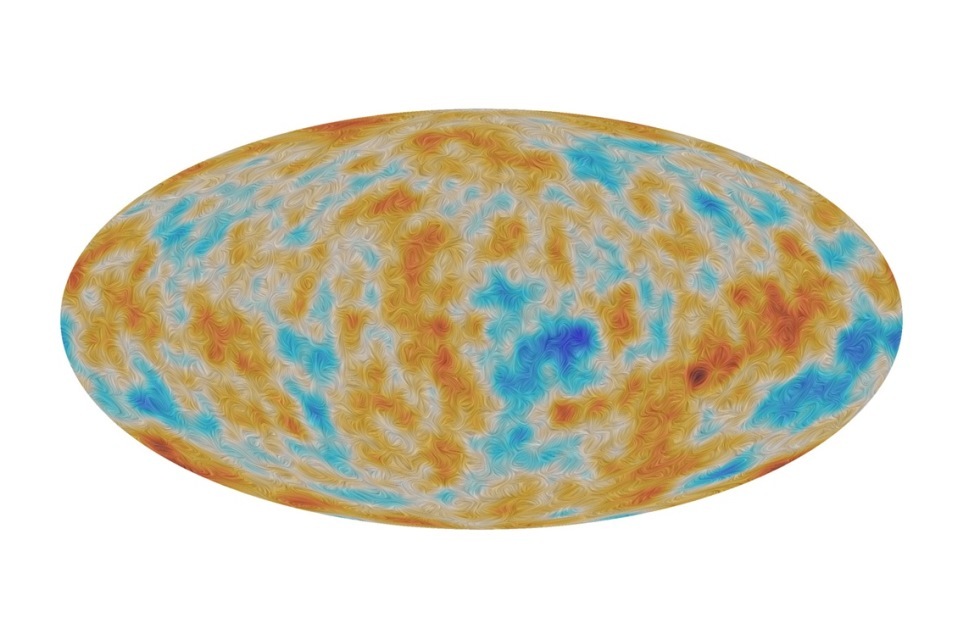First stars were born late
New maps from Europe's Planck satellite uncover the ‘polarised’ light from the early Universe.

Planck cruising to L2. Credit: ESA – D. Ducros.
This reveals that the first stars formed much later than previously thought.

Polarisation of the Cosmic Microwave Background. Credit: ESA and the Planck Collaboration.
Earlier observations of this radiation had suggested that the first generation of stars burst into life about 420 million years after the Big Bang but the new data indicates they fired up around 550 million years after the birth of our Universe.
Between 2009 and 2013, Planck surveyed the sky to study the Cosmic Microwave Background (CMB) - the fossil light resulting from a time when the Universe was hot and dense, only 380 000 years after the Big Bang. Tiny differences in the background’s temperature trace regions of slightly different density in the early cosmos, representing the seeds of all future structure, the stars and galaxies of today. The data collected by Planck confirm the standard cosmological picture of our Universe with ever greater accuracy and also carry additional clues about our cosmic history that are encoded in its polarisation.
Light is polarised when it vibrates in a preferred direction, something that may arise as a result of photons – the particles of light – bouncing off other particles. This is exactly what happened when the CMB originated in the early Universe.
Initially, photons were trapped in a hot, dense soup of particles that, by the time the Universe was a few seconds old, consisted mainly of electrons, protons and neutrinos.
Slowly but surely, as the cosmos expanded and cooled, photons and the other particles grew farther apart. This had two consequences: electrons and protons could finally combine and form neutral atoms without them being torn apart again by an incoming photon, and photons had enough room to travel, being no longer trapped in the cosmic fog. Once freed from the fog, the light was set on its cosmic journey that would take it all the way to the present day, where telescopes like Planck detect it as the CMB. But the light also retains a memory of its last encounter with the electrons, captured in its polarisation.
After the CMB was released, the Universe was still very different from the one we live in today, and it took a long time until the first stars were able to form,
explains Marco Bersanelli of Università degli Studi di Milano, Italy.
Planck’s observations of the CMB polarisation now tell us that these ‘Dark Ages’ ended some 550 million years after the Big Bang – more than 100 million years later than previously thought.
While these 100 million years may seem negligible compared to the Universe’s age of almost 14 billion years, they make a significant difference when it comes to the formation of the first stars.
The Dark Ages ended as the first stars began to shine. And as their light interacted with gas in the Universe, more and more of the atoms were turned back into their constituent particles: electrons and protons. This key phase in the history of the cosmos is known as the ‘epoch of reionisation’.
The newly liberated electrons were once again able to collide with the light from the CMB, albeit much less frequently now that the Universe had significantly expanded. Nevertheless, just as they had 380 000 years after the Big Bang, these encounters between electrons and photons left a tell-tale imprint on the polarisation of the CMB.
From our measurements of the most distant galaxies and quasars, we know that the process of reionisation was complete by the time that the Universe was about 900 million years old,
says George Efstathiou of the University of Cambridge, UK.
But, at the moment, it is only with the CMB data that we can learn when this process began.
Planck’s new results are critical, because previous studies of the CMB polarisation seemed to point towards an earlier dawn of the first stars, placing the beginning of reionisation about 450 million years after the Big Bang.
This posed a problem. Very deep images of the sky from the NASA–ESA Hubble Space Telescope have provided a census of the earliest known galaxies in the Universe, which started forming perhaps 300–400 million years after the Big Bang.
However, these would not have been powerful enough to succeed at ending the Dark Ages within 450 million years.
In that case, we would have needed additional, more exotic sources of energy to explain the history of reionisation,
says Professor Efstathiou.
The new evidence from Planck significantly reduces the problem, indicating that reionisation started later than previously believed, and that the earliest stars and galaxies alone might have been enough to drive it.
This later end of the Dark Ages also implies that it might be easier to detect the very first generation of galaxies with the next generation of observatories, including the James Webb Space Telescope.
UK involvement in Planck
The UK is playing a major role in the Planck mission. A number of UK institutes and companies form part of the consortium that built the two focal plane instruments, HFI and LFI. The Jodrell Bank Observatory at The University of Manchester produced critical elements of the LFI receiver modules and is now a key contributor to the LFI data processing activities.
Cardiff University, STFC RAL and SEA were involved with hardware development for HFI, while various UK research groups including Imperial College London and University of Cambridge form the London Planck Analysis Centre and Cambridge Planck Analysis Centre respectively.
These groups are involved with data analysis and simulation for the HFI data analysis and simulation software.
Though nominal spacecraft operations have ended, the UK Space Agency continues to fund post operational support to calibrate and archive data into a format suitable for scientific exploitation.